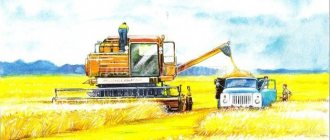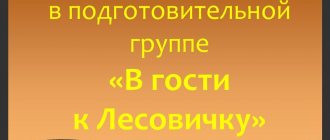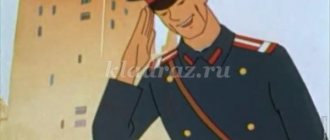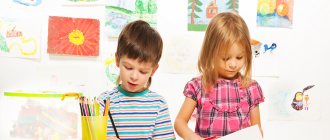Summary of a lesson on communication in the senior group
Publications on the topic:
Final lesson in the senior group on communication and cognition “Game-KVN” Goal: Practice counting forward and backward within 10. Consolidate knowledge about geometric shapes, develop the ability to classify sets.
Summary of the integrated lesson on communication “Fox-sister. Introducing the letter L" Topic: "Introducing the letter "L" Program content: - introduce the letter "L", - develop attention, hospitality, goodwill.
Summary of the final educational activity on communication in the senior speech therapy group “The Tale of the Capricious Princess” Summary of the final direct educational activity on communication in the senior speech therapy group. "The Tale of a Capricious Princess."
Summary of a correctional lesson on the development of speech and alternative communication “Retelling of the fairy tale “Turnip”” BSU SO MO Sergiev Posad orphanage for mentally retarded children “Beryozka” Summary of a correctional lesson on development.
Summary of the lesson “Dirty Masha” on the development of communication and speech skills by means of alternative communication MINISTRY OF SOCIAL DEVELOPMENT, GUARDIANESS AND TRUSTEE OF THE IRKUTSK REGION Regional state budgetary institution of social services.
Notes on communication in a mixed early group “What is good and what is bad?” Municipal autonomous preschool educational institution kindergarten No. 3 Notes on communication in a mixed early group on the topic.
Summary of the lesson on communication “Russian folk tales” Purpose. Find out whether children know Russian folk tales. Methodology The teacher reminds the children that in previous groups every year.
Lesson summary on the topic “Development of positive communication skills in first-grade students” Lesson plan on the topic “Development of positive communication skills in first-grade students” The goal is for students to acquire constructive.
Lesson summary with elements of developing non-verbal communication skills “Related words” Municipal budgetary educational institution of the city of Irkutsk kindergarten No. 15 Notes of an open correctional lesson.
Technological map of organized educational activities “Communications” in the senior group Technological map of organized educational activities Age group: senior group Educational areas: “Communication” Sections:.
MAGAZINE Preschooler.RF
Direct educational activities (communication) in the senior group on the topic “Magic words” Educator: Khudyakova O. N. Program content: Educational objectives: Developmental objectives: Educational objectives: Vocabulary work: Vocabulary activation: hello, hello, goodbye, see you, bye, good morning, good afternoon, good evening, thank you, please, sorry. Enrichment of vocabulary: greeting, farewell, gratitude, request. Material and equipment: GCD procedure: Get up as soon as the sun rises (stretch, arms up) And quietly towards the window the beam will stretch out its hand to you - (extend your arms forward) You quickly put your palm up. Let's say hello to the sun: “Hello, sunshine!” (expose your palms to the sun) Let your mother see you, washed and shod. (run your palms over your face, bend down and touch your feet) Having tidied everything up, go straight to her (walk in place) And tell her: “Good morning!” (repeat “Good morning!”) And then with a smile, in a song, go out to the grass, people, birds... (spread your arms wide to the sides) And your day should turn out to be fun, interesting! (smile at each other) The bear came out of the den, (walk in place) Looked around at the threshold. (look around) To quickly gain strength, the bear twisted its head. Mishka counted to five, Mishka lifted the weights - One, two, three, four, five. (under the count, straighten and bend your arms bent at the elbows) I will lower the weights - One, two, three, four, five. (bend over, straighten and bend your arms) I will tense my muscles.(bend your elbows, show “muscles”)
On one side of the screen there is a fortified house.
Mishka appears on the other side.
Educator: Children, look who is visiting us today! (Bear)
Why is Mishka silent and doesn’t say anything? Guys, please tell Mishka what to say when meeting? (Hello)
Bear: Hello, guys!
Educator: Bear, why are you so sad?
Bear: I'm lost and can't find my way home. Help me!
Educator: Mishka, we will be happy to help you if you ask correctly. Children, what magic word do we say when we ask for something? (Please)
Bear: I got it! Guys, please help me find my way home!
Educator: Go, Mishka, straight along this path and don’t turn anywhere.
Educator: The bear walked along the path and met the Hare.
Bear: Get out of my way, Hare, let me pass!
Educator: But the Hare stands and does not leave. Guys, why do you think? (Because you need to ask politely, say “please”) That’s right, but first you need to say hello. Do you understand, bear?
Bear: Got it! Hello, bunny! Please allow me to pass.
Bunny: Hello, Misha! Come in, please.
Educator: And the bear got ready to move on. Wait, Misha! Have you forgotten anything?
Bear: No. I didn’t have anything in my paws.
Educator: Can you guys tell Mishka what he should have done? (Tell Bunny “thank you” and “goodbye”).
Bear: Thank you, Bunny! Goodbye!
Bunny: please, Mishenka! See you!
Educator: Mishka went further, and the Fox met him.
Bear: Let me remember what the guys taught me. Hello, Lisa!
Lisa: Hello, Mishenka!
Bear: Be kind, please help me find the way to the house.
Lisa: I’ll be happy to help. come with me, I will lead you straight to the house!
Bear: And here is my house! Thank you, Lisa!
Lisa: Please, Misha! See you!
Bear: And thank you guys, you suggested amazing, magical words. I got it! Now I will always and everywhere say magic words, because they help so much! And everyone who hears them becomes kind and friendly. Goodbye, guys!
Hey Misha! I learned some polite words from you guys. What did we learn in class today? (Say hello, say goodbye, address each other and elders politely, remember polite words). Never forget these words, and you will see how kind and welcoming everyone around you will become.
| Next > |
Summary of educational activities on the social and communicative development of older preschoolers
Summary of educational activities on the social and communicative development of children in the senior group of the MDOU Nekouz kindergarten teacher Baranova T.M. “We are so different” Program content Educational objectives: - formation of ideas about twins; - development of the concept that all children are different, differ in appearance, voice, clothing, habits, hobbies, age; — development of the ability to distinguish between clothes, toys, and objects used by infants, preschoolers, and schoolchildren. Developmental tasks: - development of auditory attention, observation; - activation of words in speech: twins, baby, preschooler, schoolchild; - development of the ability to compare and correlate objects of activity with the child’s age. Educational objectives: - developing the ability to be attentive towards each other and other people; - fostering interest and a friendly attitude towards children, peers and older children. Methods and techniques: surprise moment, outdoor game, questions, TRIZ technique “What would happen...”, comparison, use of illustrations, audio recordings, modeling, game exercise, encouragement, drawing a self-portrait. Equipment: magnetic board, ball, cards with images of children of different ages (baby, preschooler, schoolchild), the game “Who needs it,” sheets of paper, pencils, paints, a mirror for each child. Preliminary work: examination of illustrations depicting children of different ages, game “What do boys need, what do girls need?”, conversation about children’s hobbies.
Progress of the situation The group includes Dunno. Dunno: Hello children! Hello adults! There are so many of you here. How different you all are. I want to get to know you and learn a lot of interesting things about you, so that I can then tell my friends in Sunny City. I invite everyone to hold hands and smile at each other (holding hands) Educator: Hello, Dunno! We are all glad to meet you. All the guys want to tell a lot of interesting things about themselves, and the game “Tell about yourself” will help us with this (to the music, children pass the ball, and whoever the music stops on tells something about himself) Dunno: Can I start! My name is Dunno, I really like to play with my friends. Game "Tell me about yourself."
Dunno: Oh, so many different names, different faces!
No, I won't remember all of you! It would be nice if everyone were the same: with the same names, voices, faces. Then it would be easier for me to remember you. Educator: No, Dunno, all our children are different and we don’t want them all to be alike in everything, like two peas in a pod. Really, guys? Educator: Let's think about what will happen if all the children are the same (children's answers) Dunno: Well, okay, you convinced me, well done. I will try to remember you all. Educator: Dunno, we can tell you a lot of interesting things about ourselves and other children who go to kindergarten. Sit on the chairs with your children. Educator: Yes, children, you and I are all different. Do you know that people who are identical in appearance still exist? Do you know, Dunno, what they are called? Dunno: No! Do you know? Educator: They are called twins. There is a knock on the door, twin boys come in and say hello.
Educator: I invited the boys from the preparatory group to visit. These are twin brothers - Savely and Maxim. They were born on the same day, to the same mother. And they have the same birthday. You know them all and have played with them on walks more than once. See how they are similar? (children's answers) How are they different? (children's answers) And now I suggest everyone, both the children and the guests, to relax a little.
Physical education minute. One-two-three-four-five We will jump and gallop, The right side bent over - One-two-three The left side bent over One-two-three. Now let’s raise our hands and reach for the cloud, One-two-three-four-five And we all sit down again. (children sit down) Twin boys: We enjoyed visiting you, but it’s time to return to the group. We want to give you a game that we love to play with our friends (the boys say goodbye, leave)
Educator: Now let's see what the boys gave us. There are pictures in the box (places them on the board) Who is this? (children) Are they all the same age, do you think? Who is this? (schoolboy) Who is this? (baby, baby) And this? (preschooler) I suggest that one of you post the pictures in order as the age of the children changes. One of the children goes to the board, puts the pictures in order (infant-preschooler-schoolchild) and tells. Educator: Yes, look, children differ not only in hair color, eyes, clothes, but also in age. A child is born, and he is called ... (baby, baby), he has grown a little, went to kindergarten, and now he is already (preschooler), time has passed quickly in kindergarten, it’s time to get ready for school, and everyone will call the former baby (schoolboy ) Who are you guys - babies, schoolchildren or preschoolers? (children's answers) Oh, look, there are also pictures in the box with different objects drawn on them (show a few pieces). Now I will give them to you, and we will play with them. Dunno, please help me hand out the cards (they are handing out) Look carefully to whom the item you have drawn may belong to - a baby, a preschooler or a schoolchild. And find the right place for the picture on the board (children attach cards - under the picture with the baby there are objects for him, etc.) Let's look at whether all these items are needed (for the baby, etc.) Educator: Dunno, do you know that People can also be distinguished by their voice. Now we will all play our favorite game “Snail”. Purpose of the game: recognize your friend by voice. Equipment: snail mask-cap. Progress of the game: the driver (snail) stands in the middle of the circle, he is blindfolded. Each of the players, changing their voice, asks: “Snail, snail, Stick out your horns, I’ll give you sugar, A piece of pie. Guess who am I." The one whose voice the Snail recognizes becomes the Snail himself. Educator: Dunno, did you like it with us? Dunno: Yes, very much! You are all so different, kind, funny and very interesting to be with. I will definitely tell my friends in Sunny City about you, but I won’t be able to show them what you are like... Educator: How can I help you, Dunno? What do you guys think can be done? (take a photo, but don’t have a camera, or you can draw a portrait of each and give it to Dunno). Educator: Of course, you can draw your own portrait for everyone, but don’t forget that you don’t look alike, everyone has their own eye color, hair color, and favorite clothes. There is a mirror on the table in front of each child, the children draw self-portraits and give them to Dunno.




